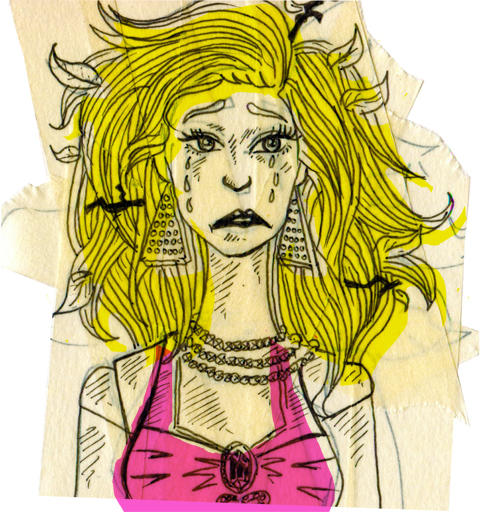
Illustration by Charlotte Hoyle
“We are consumers, capsule addicted. We need to ask ourselves – this t-shirt, this where did it come from? A devastated place with devastated people?” – Bia Saldanha, health 28 July 2011??
Through Bia’s hesitant English – impressively peppered with the vocabulary of her respective fields – there was a message, a mantra, that seemed to resonate from her core with every sentence she spoke. The message? That as people, as a united force of humanity, we must end the selfishness, stop the excuses and start acting on the fact that our Earth cannot bear the brunt of our reckless lifestyle choices much longer. ??I was sitting at the far back of the still, woody space of The Hub, King’s Cross, looking on at Bia, eco journalist Lucy Siegle and novelist Ed Siegle’s discussion unraveling.
If there’s one thing I learnt on that warm Thursday evening, it’s that when a lady like Bia Saldanha gives out such a message from across the room, you sit up straight, strain your ears and listen. Living in the heart of the Amazon rainforest for 20 years definitely grants you a credible opinion on our Earth’s complex ecosystem and how it can be saved. And it only takes a minute or two of hearing Bia speak on the subject to get a sense of just how special she really is. A Brazilian woman who’s dedicated her years to both supporting the indigenous rubber farmers of Amazonia and aiding the battle against deforestation, Bia traded in a life running a stylish clothing boutique in Rio de Janeiro to live in the rainforest with her family and help the Seringueiros (the native rubber tappers) overcome their defeat by mainstream industrial production.

Illustration by Michelle Urvall Nyrén
But why should we care? Why should we listen? We all know of the damage upon the rainforest through mass deforestation and, for example, that Brazil lost nearly 150,000 square kilometers of forest—an area larger than Greece – between 2000 and 2006 alone. But the basis of why we should think again before discarding these past few lines as just another statistic lies in the words of Lucy Siegle; that we are in “the last chance saloon” when it comes to saving the rainforest. And, to further quote the fabulous Bia,
“You can’t imagine how strong, powerful and important the rainforest is if you haven’t been there”.

Illustration by Claire Kearns
With a background in the fashion industry, Bia began her pioneering work after a trip into the Amazon to search for new materials for her clothing line. She described how she found the indigenous rubber tappers storing their goods in traditional waterproof sacks. She then relayed her excitement of noticing how the sack material looked remarkably like leather when it was, in fact, cotton canvas covered in the extracted rubber from the trees. Bia took the idea for wild rubber “leather” handbags and had hundreds made, all of which completely sold out in the 1992 UN Earth Summit in Brazil. And so her crusade against the mass producers began. ?
The Amazon is, in fact, the only place in the world where rubber trees grow in the wild. When ecological and fair-trade brand Veja began their essential collaboration with Bia in 2007, they were already buying wild rubber from the rubber tappers. Veja are a French brand known for their ultra-cool sneakers and luxe accessories, whose products are sourced and produced solely in Brazil. They now work with Bia and use her independent, direct means of extracting wild rubber to produce their bags and footwear.
VEJA – CAOUTCHOUC SAUVAGE D’AMAZONIE from Veja on Vimeo.
In what can only be seen as a triumph in the fight for sustainable fashion, Bia Saldanha has also worked with Hermès, using her ‘vegan leather’ made of wild rubber to collaborate on an accessories collection for the luxury French fashion house.
Despite the dedication and ground-breaking work that’s been recognized the world over, however, Bia hasn’t received the support she justly deserves. In the discussion, she spelt out the level of sheer power and influence that Brazil’s central bank has over what is and isn’t permitted to function in the country. After struggling against many financial disagreements, Bia even faced being shut down completely, despite the continuous funding to unsustainable companies and projects, including the vast amount of cattle ranches that make up 60-70% of deforestation in the Amazon today.?
“I’ve now devoted 16 years to this,” said Bia. “It’s more than a business; it’s a cult.”

Illustration by Charlotte Hoyle
It’s not that she aims to trade with the giant companies, however. “There’s not enough wild rubber to supply the big companies. We don’t want to trade with anyone in particular but we do want to ask those companies, where does your rubber come from? These companies are just looking for marketing, they don’t care.”
Ed Siegle, author of new book Invisibles which is partially set in Brazil, contributed stating “With a lot of these issues, we’re all aware of them but we don’t do anything about it.” Lucy intervened – “That’s because we don’t know what the options are.”
To me, Lucy Siegle made an invaluable contribution to the event. She spoke of writing her latest book ‘To Die For” (Harper Collins; 2010) which she described as “engaging with the producer’s story”, and how she felt about the “contrast between her and the mainstream industry”, recounting fashion as a “vacuum that we know nothing about”. “We are now so distant from the producer,” she said “that the degradation of the consumer, the producer and the place is now inevitable.”
She went onto ask the frustrating question, something I’d never put my mind to, of “Who are these people telling us what to wear? Telling us to buy this fast, discount fashion?” She feels that we are “told to shop for the economy”. Her answer to this has been to find a few brands that she can “rely on”.
The discussion moved on to the debate of ‘design and production – which should come first?’. Lucy Siegle, naturally, spoke in favour of production, upholding it as the healthier method in place of paper designs being sent across the world for the fastest and cheapest production possible. She believes instead that we need to be taking inspiration from the methods of Bia, who at the outset went into the forest – to the source – in search of materials, from which she then created her designs. This, she says, is a solution.
Bia declares that her long-standing mission is to “protect the rainforest through economic alternatives”. And I say we need more ground-breaking fashion entrepreneurs like her. In the constant clash between nature and human demands, the more Bias we have in the world today, the brighter our future will be.
And with this mantra that seemed to beam from Bia’s every sentence; she most certainly wasn’t aiming it at the big logger companies or sweat shops or factories, definitely not. It’s US she meant. All of us. It’s you who sits right there wearing clothes that you really know nothing about. Someone’s hands, somewhere in the world, grew that cotton and dyed that fabric and stitched that pocket and, thus far, to you in your life it has made no difference. We’re all perpetrators and I’m most certainly one too. But after last Thursday, I’ll definitely be doing two things – reading Lucy Siegle’s book “To Die For” and taking a long, hard look at me and my wardrobe. And may I suggest you do the same.
Categories ,Amazon, ,Amazonia, ,Bia Saldanha, ,brazil, ,Ed Siegle, ,environment, ,ethical, ,fashion, ,Invisibles, ,Lucy Siegle, ,rainforest, ,review, ,Sustainable Fashion, ,Talk, ,The Hub, ,To Die For, ,Veja
Similar Posts:
- Hero of the Week
- Veja launch ‘Projet Numero Deux’ – satchels and sacks, ethical style
- Novo Mundo(s)
- Viva Veja!
- New Comptoir des Cotonniers trainers






















